This month's can is a surprise! Heck, it's technically not even a beer can, but it's pretty darn close, especially for a can from Prohibition (1919-1933). It's a Red Top Malt Extract can, perfect for home baking brewing!
Red Top Malt Extract, Circa 1920-1933
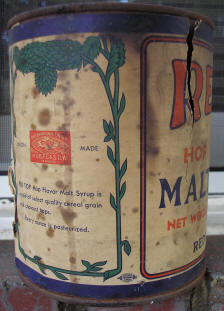 |
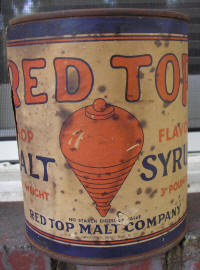 |
 |
Red Top Malt can, yes, it's still full. I sure don't want to open it!!!
Red Top Malt Company
Usually when someone thinks of making illegal liquor during Prohibition the images that often come to mind are of a still in the backwoods somewhere, of 'bathtub gin", or of mobsters in Chicago smuggling liquor across the border from Canada. A lot of home brew, however, was just that, something brewed at home. A lot of breweries tried to survive Prohibition by making malt syrup for home "baking". Malt is grain (usually barley) that is soaked in hot water until it germinates (i.e. sprouts). At that point it is dried. The resulting product is called "malt". It has less moisture than the original grain, and is better suited to undergo the chemical changes necessary in brewing. (Definition from William L. Downard, Dictionary of the History of the American Brewing and Distilling Industries. (Westport, Conn. Greenwood Press, 1980)).Home brewing instructions were easy to find, often available at the local library in the household or "useful arts" section. Some malt stores gave away instructions for free. Old bottles were cheap and reusable and bottle caps and capping machines were readily available, usually at the same stores that sold the malt extract. Customers could buy everything they needed at Woolworth's or A&P or Piggly-Wiggly or at many other dime stores or groceries as well as from specialty shops. A popular poem of the time noted how home brewing would be a family affair..
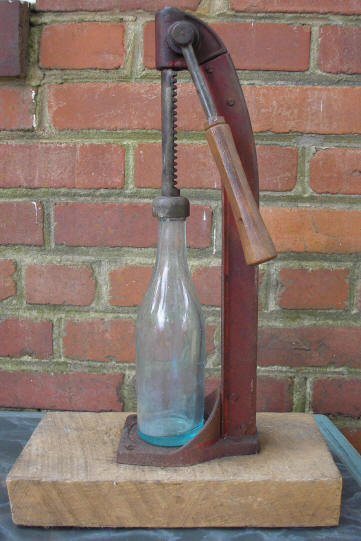 |
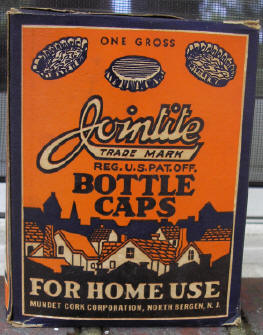 |
| A prohibition-era bottle capper (with bottle shown for scale) |
A box of bottle caps "for home use." |
When Prohibition began in 1920 there was no large market for malt extract and only a few small companies made it. It was also a minor side product sold by a few of the established breweries. However, by 1928 there were more than 100,000 stores selling 450 million pounds of malt syrup. The federal Prohibition bureau estimated in 1929 that Americans had brewed over 700 million gallons of home brewed beer that year. One new malt company which profited from this home brew business was Cincinnati's Red Top Malt Company. Red Top was founded by Louis Ullman and Edgar Mack Sr. in 1904. Prohibition gave them an opportunity to expand their business. By 1928 they had made enough profits that they began looking for a new facility. Cincinnati's Hauck Brewing Company had closed in 1927 after failing to make a profit selling near beer. Red Top bought the facility along Central Avenue and Dayton Street and continued production. They marketed their malt throughout the eastern midwest, along the mid-Atlantic and probably into the south.
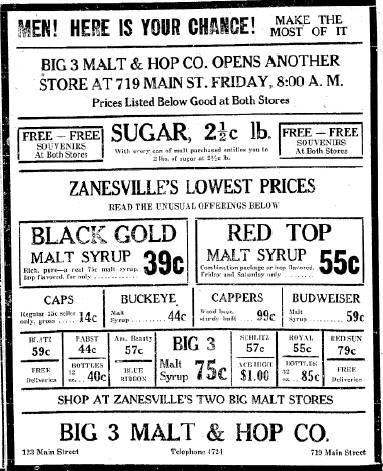 |
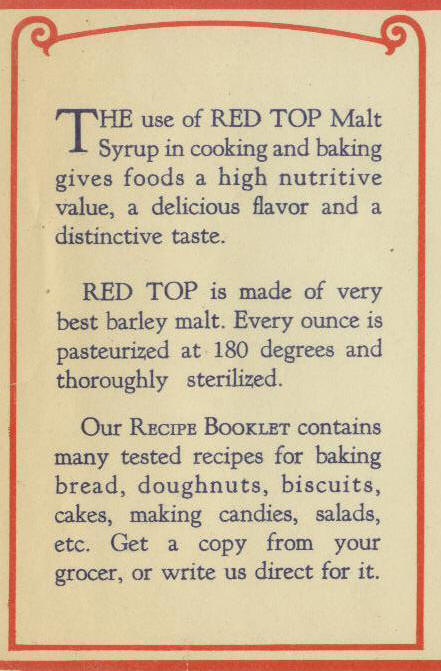 |
| A malt store ad from Zanesville, Ohio, 1928. |
Red Top Label side panel from 1930. |
The ad on the left is from a store in Zanesville, Ohio. It appeared in the Zanesville Signal on September 15, 1928. It advertises numerous malt syrups, some bearing the names of famous brands of beer including Blatz, Pabst and Schlitz. The store also sells bottles for 40 cents each as well as bottle caps for 14 cents a gross and bottle cappers for 99 cents. Such items were perfectly legal in 1928 as they also had "legitimate" ( i.e. non-alcoholic beer) uses. The label on the right is from a 1930 can of Red Top Malt. Of course it doesn't mention its use in making beer, but instead emphasizes its uses in cooking and baking.
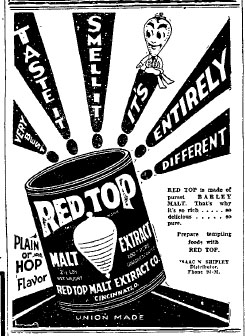 |
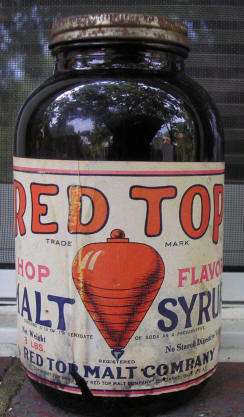 |
| A Red Top Malt ad from 1929. | A bottle of Malt Syrup dated 1921. |
I will save the story of the brewery, which closed in 1957, for next month's Can-of-the-Month. But, briefly, when Prohibition ended the Hauck Company considered restarting brewing. However, they remained uncertain and their old brewery was now leased by the Red Top Company. In April 1933 Red Top filed for a formal charter to open the old Hauck facility as the Red Top Brewing Company. Hauck gave up any ideas about reopening and Red Top began operation. They continued using the Red Top name on their beers and even noted on their labels that it was "Made in the Former Hauck Brewery" for several years. In 1936-1937 they doubled their production capacity and added bottling lines. They were also one of the first to use cans, starting in August 1935 as the sixth brewery to use the new container. Operating losses forced the brewery to close in early 1957.
A Mystery: Solved!
When I started this page I took some photos of what appeared to be another Prohibition-era can of Red Top Malt. When I searched the label for a copyright date, however, I found the label has includes the zip code for Cincinnati! Zip codes were created in 1963. Did the Red Top Malt Company survive the failure of Red Top Brewing in 1957? If you have any information please email me at Mark@rustycans.com!
UPDATE: a nice lady emailed me to say that she used Red Top malt in the 1960s and 1970s. She noted it was available in grocery stores in eastern Kentucky and that it made a good basic brew. She asked if I knew if it were still available. I couldn't answer her question but she answered mine. I also heard from someone in West Virginia who bought Red Top malt in Kroger's in West Virginia in the 1970s. Apparently Red Top Malt Syrup survived the failure of Red Top Brewery by at least 20 years. (Thanks to Joyce and Charles.)

The zip code!
Sources Used:
Downard, William. Dictionary of the History of the American Brewing and Distilling Industries. (Westport, Conn. Greenwood Press, 1980)
Holian, Timothy. Over the Barrel: The Brewing History and Beer Culture of Cincinnati, Volume 2-Prohibition-2001. (St. Joseph, Mo.:Sudhaus Press; 2001) I can't say enough good things about Tim Holian's two volume history!
Jabloner, Amy. "Home-Brewing During Prohibition" (December 1997).
